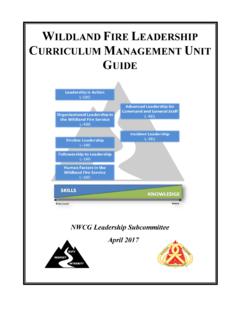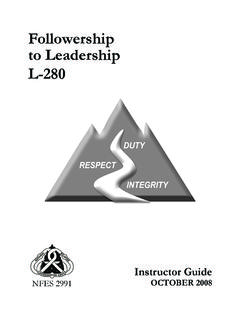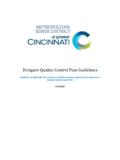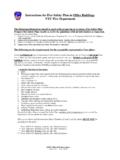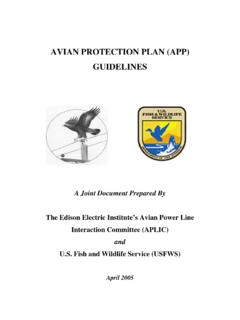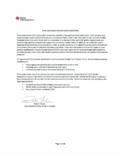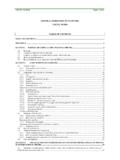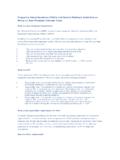Transcription of General Guidelines for Charting Your Career Path
1 TTHHEE IINNDDIIVVIIDDUUAALL DDEEVVEELLOOPPMMEENNTT PPLLAANN GGUUIIDDEE General Guidelines for Charting Your Career Path Wildland Fire Leadership development Program April 2010 i TABLE OF CONTENTS Credits .. ii Introduction .. 1 What is an IDP? .. 1 When to Prepare an IDP .. 2 What s in an IDP .. 2 Core Competencies and Behaviors .. 3 Responsibilities .. 4 Employee .. 4 First-Line Supervisors or Team Leaders .. 4 Procedures .. 4 Where Am I Now? .. 4 Where Do I Want To Be? .. 5 How Will I Get There? .. 5 What Is My Current Level of Competency? .. 5 Employee Checklist for Preparing an Individual development plan .. 6 Identification of Personal Goals .. 6 Identification of Organization Goals .. 6 Identification of Objectives .. 6 Identification of development Activities .. 6 Supervisor Checklist for Reviewing Individual development Plans .. 7 Reviewing the IDP.
2 7 Analysis of Organizational Needs .. 7 Developmental Activities .. 8 Frequently Asked Questions .. 9 Tips for the First-Line Supervisor or Team Leader .. 10 Definitions .. 11 ii CREDITS The Wildland Fire Leadership development Program would like to thank the Uniformed Services University for allowing us to adopt this publication and adapt it for use within the wildland fire This guide explains the responsibilities of the employee and supervisor in completing the Individual development plan (IDP) and outlines a step-by-step process for preparing an IDP. The IDP is developed by the employee and their supervisor. As the IDP is built, the employee and supervisor will outline development objectives and Career goals. The employee and supervisor will also select learning activities for achieving these objectives and goals. The purpose of an IDP is twofold.
3 First, it ensures that the employee maintains the current level of job proficiency through continued training and developmental activities. Secondly, the employee charts a Career path by identifying new knowledge, skills and abilities to pursue, as well as learning activities needed to reach the established goals. Third, the IDP will support organization mission and Career field needs. While your agency may not require all employees have IDPs, it is strongly recommended one be prepared. This guide will help you: Analyze your Career goals and objectives. Learn how to make IDPs. Prepare your formal IDP. Analyze the organization s needs for individualdevelopment planning. Get ready for the employee-supervisor conference. Find and use resources for individual development planning.
4 WHAT IS AN IDP? IDPs are individually tailored and describe objectives and activities for the employee s Career development . IDPs can be a win/win strategy because they benefit both the employee and the organization. Employees benefit, because implementing an IDP helps them enhance their knowledge, skills, and experiences. Improved competencies help them achieve personal and Career goals both inside of and external to the organization. The organization benefits by developing improved employee capabilities, work load planning, and resume needs. Competent employee performance, plus the added bonus of improved moral, and personal job satisfaction can make the organization more effective. IDPs work by helping an employee and supervisor clarify things that are important to them and plan to achieve them. In the IDP are Career objectives, and the knowledge, skills and abilities needed to achieve these objectives, as well as, activities that will provide employees the opportunity to learn and apply the knowledge and skills.
5 1 An IDP is a written plan for the benefit of both employee and supervisor. It describes competencies that the employee will apply and enhance and how this development will occur. This includes the following: Responsibility areas IDPs describe the areas of responsibility assigned to the employee as stated in his/her position description and the competencies needed to perform the responsibility. Developmental activities Each responsibility area is accompanied by one or more specific developmental activities that will enable the individual to achieve or practice that competency. Time line with milestones and date completed Realistic start dates, end dates, and other major milestones are established for each activity. The date completed should be listed when the employee can document proficiency based on the competency, skill, or ability obtained.
6 WHEN TO PREPARE AN IDP Timing is an important factor in developing the IDP because the following processes work together to establish the same objectives: The performance appraisal. The training needs analysis. Career development planning. The IDP. The optimum time for preparing the IDP is during the first few weeks immediately following the performance appraisal. WHAT S IN AN IDP An IDP should include all of the developmental assignments, activities, and training courses indicated for the employee as a result of the: Training needs analysis. Mandatory or core competencies. Career counseling. It should include: Any activity that is intended to improve performance at the employee s present position or a target position. The desired time frame for completion of CORE COMPETENCIES AND BEHAVIORS The Fire Administration (USFA) and the National Wildfire Coordinating Group (NWCG), working on behalf of the National Integration Center Incident Management Systems Integration Division (Department of Homeland Security), have identified and compiled the core competencies and behaviors for each ICS position identified in the National Incident Management System (NIMS) and in the National Interagency Incident Management System Wildland Fire Qualification System Guide PMS 310-1.
7 The NWCG developed core competencies and behaviors for all additional (non-ICS) NWCG positions. (See ) These competencies and behaviors form the basis for position specific training, position task books (PTBs), job aids, and other performance-based documents. There are three primary benefits of identifying competencies: 1. Competencies are a national benchmark they standardize qualifications without interfering with local decision making about training. 2. Shared competencies make interagency crossover and collaboration easier. 3. Competencies are a critical component for the development of performance-based training. The following brief descriptions will help distinguish between the terms competencies, behaviors, and tasks : Competency A broad description that groups core behaviors necessary to performa specific functionBehavior A General description of an observable activity that is a logical andnecessary action in the performance of a behavior; how the behavioris demonstrated or performed in a particular contextTask A specific description of a unit of work activity that is a logical andnecessary action in the performance of a behavior; how the behavioris demonstrated or performed in a particular context Competencies and behaviors among positions are similar.
8 This similarity may hide critical differences in proficiency level and the environment or type of incident in which the position is expected to perform. These critical differences are typically captured in the tasks of each position. 3 RESPONSIBILITIES EMPLOYEE Each employee has the primary responsibility or working closely with their supervisor to develop and monitor his or her IDP. This includes: Identifying short-and long-range goals, developmental objectives, and activities to achieve these goals. Identifying additional knowledge, skills, and abilities required to achieve the stated Career objectives. Discussing and obtaining concurrence of goals, objectives, and developmental activities with first-line supervisors or team leaders. Satisfactorily completing all assigned reading, education, and developmental assignments.
9 FIRST-LINE SUPERVISORS OR TEAM LEADERS First-line supervisors or team leaders are responsible for assisting each of their employees in the development of their IDP and supporting developmental activities outlined in the IDP. This includes: Performing a developmental needs assessment, in cooperation with the employee, to assist the individual in planning and formulating actions to successfully accomplish identified Career objectives. Counseling employees concerning Career development and encouraging employees to set goals to improve their performance through systematic and continuous self- development . Assuring that developmental activities support the objectives of the IDP. Evaluating the development , activities, and training completed by each employee. PROCEDURES WHERE AM I NOW?
10 Conduct a self-assessment to determine current skills, interests, and values. In addition to an assessment of current job strengths and areas of improvement, ask questions such as: What do I value? How satisfied am I in my current job? How well does my job meet my needs? If I wanted to make a change, what would it be? How do others see me? How do I want to be seen? What kind of personal do I want to be? What makes me happy? 4 WHERE DO I WANT TO BE? vqIfTaayOnce you have reviewed your current skills, interests and alues, begin to examine the options available. Ask uestions such as: Do I want to move up or over to a new organization? Do I want to enrich my present job? Do I want to develop new skills? so, which ones and why? alk with supervisors and managers and see what options re available.
